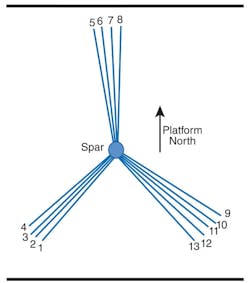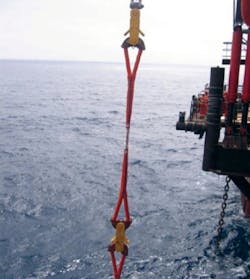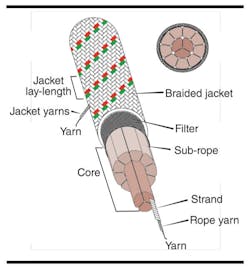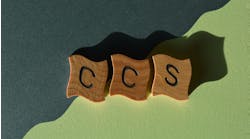Chevron's Tahiti project sets new standards for deepwater mooring specifications
Sergio Leite
Lankhorst Ropes
Paul E. Griffin
Chevron
Reijo Helminen
Technip
David S. Rowley
Offspring International
Deepwater and ultra deepwater fiber rope, taut leg mooring systems are today a very important part of the total Gulf of Mexico oil and gas production. The largest polyester ropes ever made were produced for Chevron'sTahiti truss spar in the GoM. For this project, the Lankhorst Ropes offshore division manufactured over 28,000 m (92,000 ft) of the Gama 98 polyester rope with a 254-mm (10-in.) diameter and a 1,907 metric tons (2,100 tons) minimum break load (MBL).
Deepwater moorings are different from other rope applications. They are installed long-term – typically 25 years – and are under constant strain. Therefore, their design and production should reflect the engineering demands on the rope.
Reducing rope length tolerance from ± 2% to ± 0.5% was achieved using a length measuring system (LMS) that measures the rope length at known reference load during manufacturing. The laser length measuring system was used to fulfill the requirements, enabling the rope manufacturer to achieve the requested length tolerances. Enhanced rope traceability was achieved by increased monitoring and recording of rope splicing for each of the project's 84 splice eyes.
Improved logistics in the handling of empty rope reels and their reuse was achieved by using environmentally modular transport reels and cradles (by M-Reel) which can be disassembled and reused.
All of the offshore production line improvements were completed within the project schedule, enabling the ropes to be manufactured in a record time of six months, easily achieving the due delivery date.
Tahiti project
Discovered in April 2002, Tahiti is one of the largest discoveries in the Gulf, with estimated total recoverable resources of 400 to 500 MMboe. Tahiti is a major asset for Chevron (58%), the operator; and also for its joint venture partners Statoil (25%) and Total (17%).
TheTahiti spar platform covers Green Canyon blocks 596, 597, 640, and 641, approximately 305 km (190 mi) south of New Orleans in 1,250 to 1,310 m (4,101 to 4,297 ft) of water. Production lies below a salt canopy ranging from 2,439 to 4,572 m (8,000 to 14,999 ft) thick. The primary reservoir, which represents more than 80% of the recoverable volume, is buried at depths of 7,000 to 8,500 m (22,965 to 27,887 ft). The deepest producing well is more than 8,140 m (26,705 ft), a record for the GoM. Production is from two subsea drill centers tied backed to a floating production facility supported by the Tahiti truss spar. First oil was achieved on May 5, 2009. Daily production is approximately 125,000 bbl of crude oil and 70 MMcf of natural gas.
Lankhorst Gama 98 polyester rope was selected for theTahiti spar mooring lines. This was the first time Chevron had used polyester rope for a permanently moored floating facility. The benefits of polyester rope moorings over alternative materials are that it is lighter, easier to handle, and has the mechanical properties necessary to withstand the loads and elasticity demands of deepwater mooring.
Polyester rope gives a "softer" mooring system than steel wire rope; and, consequently, theTahiti spar motions are more compliant and riser friendly. Until Tahiti, a spar traditionally had a dry tree with top tensioned production risers. For Tahiti, the favorable motions characteristics of the spar enabled successful fatigue design of the sour service high-pressure/high-temperature (HP/HT) steel catenary risers (SCR) without use of corrosion resistance alloys. Use of polyester mooring improved hull vortex induced motion response to loop currents relative to traditional chain-wire-chain mooring and enabled SCR departure angles to be reduced. Consequently, Tahitiis the first wet tree truss spar in the Gulf of Mexico.
TheTahiti spar is held in place by 13 mooring lines in three clusters of 4-4-5 lines. In addition to 26 polyester rope segments, six of the 13 lines each includes two rope test pieces.
Rope test inserts
The number of rope test pieces was determined by the design life of the mooring system – in this case 250 years.
When the spar was installed, the US Department of the Interior's Minerals Management Services (MMS), Gulf of Mexico OCS Region, required that a polyester rope insert be tested routinely every five years, and after major storms.
The latest Notice to Lessees and Operators (NTL) allows new facilities equipped to record environmental and mooring tension data during major storms to only remove a test insert if the recorded tension in any line exceeds 70% of MBL.
After a significant event, the operator has to demonstrate that the mooring ropes are still fit for purpose, and one method is to test a rope insert. These tests subject a selection of sub ropes extracted from the insert to break load testing and fatigue analysis. Microscopic analysis is also used to check for yarn-on-yarn abrasion.
Rope manufacture
Lankhorst reviewed its manufacturing processes and undertook several plant upgrades and factory improvements; these included a new 80 metric ton (88 ton) take-up unit, a longitudinal in-line painting system, radial marking for every 75-m (246-ft) rope length, and some civil engineering to reinforce the standing storage area.
Rope length measurement
At the project outset, it was a requirement that each polyester rope mooring line should be within ± 0.5% of the correct length after post-installation tensioning. This marked a significant reduction in rope length tolerances from ± 2% for deepwater mooring lines.
Reducing the rope length tolerance has a number of practical and financial benefits. Overall length accuracy is important so that the top chain length can be minimized. A 0.5% line length "safety margin" in the top chain may be worth millions of dollars. A 50-m (164-ft) top chain length saving per line on a 12-leg mooring system equates to savings of approx. $700,000 with R4 chain, and nearly $1 million for Grade 5 chain. Conversely, if the mooring line is too short, the lines are difficult to install and need higher pre-tension. This results in an extended offshore installation time for the mooring lines.
If the mooring line is too long, it may not be possible to reach the required pre-tension, leading to uneven share of line loads and greater platform offsets. Also, the polyester line is closer to the surface where it is subject to UV light, marine growth, and greater wave movement which can be potential fatigue issues.
Rope length testing
Understanding a rope's stiffness and stretch is important when designing deepwater mooring systems. Stiffness affects the required rope break strength, and permanent stretch influences the required rope length. In addition, stiffness and stretch have a bearing on the maximum platform offset, and, therefore, the required riser length.
Mooring tensions and maximum mooring line stretches caused by hurricanes and loop currents were calculated. Consequently the total permanent stretch over the service life of the mooring is accurately predicted, and the required length take-up determined.
Achieving a ± 0.5% rope tolerance on rope segments of Gama 98 was achievable only by measuring the rope under tension during manufacture. Predicting the change in length during installation and post installation tensioning was achieved through independent testing by Det Norske Veritas.
Rope construction
Gama 98 polyester rope tethers are made from high efficiency sub-rope cores laid parallel within a filter element and an outer braided jacket. Filter elements between the jacket and sub-rope cores are used to filter out particles greater than 5 microns whilst allowing free flooding of the rope. The filter, in turn, is covered with a braided outer jacket for protection during handling. This jacket features a red and green color scheme to provide a visual check on the integrity of the jacket.
Each sub-rope is computer monitored during tether manufacture to ensure each has equal tension and length. Typically, Gama 98 ropes include up to 12 sub-ropes, each sub-rope being of a long lay length which affords a 100% torque free rope. The required breaking strength dictates the diameter of the sub-rope, in this case a 70-mm (2.75-in.). The Tahiti rope weighs 42.6 kg/m (≈31.3 lb/ft), with a diameter of 254 mm (10-in.) and an MBL of 1,907 metric tons (2,100 tons).
Rope splicing
As mooring lines are used in greater water depths further offshore, the engineering integrity of the mooring rope and its splice are critical to station-keeping. Each Tahiti mooring line is made up of platform chain, H-link, polyester rope segment, H-link, polyester rope segment, H-link, bottom chain, mooring connector, and anchor.
Each rope segment connection is done by splicing the rope to produce an eye-shaped connection. The quality of the splice is vital to the integrity of the mooring line. For example, the Gama 98 sub-ropes are color-coded for identification purposes so that they have the same position throughout the rope, within each eye, and are spliced to themselves.
Deepwater rope construction involves multiple sub-ropes which end either in hand splicing terminations or, potentially, socket terminations. The eye splice is engineered for high efficiency strength. To achieve this, each sub-rope is allocated a preset position around the eye so the load is shared equally. In the ideal splice, each sub-rope is exactly the same length. In reality there always is some variation.
Unequal length variation among the sub ropes means unequal loading on the shortest sub-rope in the eye, resulting in a shorter fatigue life. Failure of the shortest rope initiates a domino effect as the next shortest rope it in turn takes an increasing load leading to catastrophic rope failure. It follows that the maximum break load of the assembled rope is governed by the length variability of each sub-rope within the rope.
Rope splicing is only performed by trained splicers. Each splice is logged into a splicer's database, with each splice photographed 15 times during production of each eye. This gives full traceability which each photo containing the rope number, splice number, operator name, sub-rope identification, and date. In total, 84 eyes were spliced producing a total of 1,260 photos providing a complete record of production of all the Tahiti splices.
Rope testing
Testing of the Tahiti ropes was conducted by DNV to American Bureau of Shipping guidelines. Initially, 10 prototype rope constructions were tested for linear density, break strength, extension and creep, static and dynamic elastic modulus, tension-tension cycles (80,000), axial compression cyclic, and break strength. This showed that the Gama 98 rope met project requirements. Subsequent testing of three production rope samples showed an average breaking load of 2,050 metric tons (2,259 tons) – a difference of only 17 metric tons (18.7 tons) between the three samples. This is a 0.43% coefficient of variation.
Acknowledgment
Based on a paper presented at the Deep Offshore Technology International conference and exhibition held in Amsterdam, the Netherlands, Nov. 30-Dec. 2, 2010.
Offshore Articles Archives
View Oil and Gas Articles on PennEnergy.com








